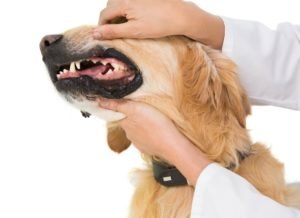As we’ve written about before here on GeoZoo, dog grooming is essential and it’s one of the most important parts of keeping our little friends healthy and happy.
Proper grooming should never be neglected.
However, there’s one HUGE part of grooming that many owners forget about, oral care.
Just like humans, dogs suffer from dozens of different conditions that can harm their teeth and mouth. Although most dogs don’t show signs of pain, dental problems can make them feel uncomfortable and could lead to other, potentially dangerous, complications.
In this article, we’ll discuss dog dental care, how to check a dog’s gums, and warning signs to look out for.
How to Check the Gums and Teeth
 If you have an older dog and have never checked their gums before, this might be a little tricky as the new sensation of an oral checkup might be a little much for your dog . That’s why it’s so important for owners to teach their dogs about all types grooming from an early age.
If you have an older dog and have never checked their gums before, this might be a little tricky as the new sensation of an oral checkup might be a little much for your dog . That’s why it’s so important for owners to teach their dogs about all types grooming from an early age.
The procedure is simple, gently grab your dogs’ upper lips and slowly pull them up until you reveal the gums and teeth. Make sure you can see the whole mouth and can examine all the teeth.
Some dogs may fight this if they’re not used to you grabbing their mouths, but it will only take a moment to check your pet’s gums. So try to calm them down and give them positive reinforcement once you’re done to keep them happy
What to Look For
Once you have exposed the dog’s gums, you’ll have the chance to check to see if their gums are healthy. You may not have the experience to notice all the details of your dog’s health at a glance, but you can check for any abnormalities and get them to the vet quickly before a potential condition worsens.
The first thing you’ll notice is probably your dog’s breath. If the smell is foul and/or abnormal, it could be a sign of a possible dental problem. However, it could also come from something the dog recently ate – so you may want to check back again after a while or after brushing their teeth.
A dog’s healthy gums should have a pale pink color, similar to cooked shrimp. If the gums are dark red and/or inflamed, the dog could have gingivitis. If the gums are pale, it could be a sign of anemia. Any other color could also signal a potential disease, so consult your vet.
Besides the gums, you must also check your dog’s teeth. Look for any discoloration and/or plaque formations on the teeth. Also keep an eye out for any loose or chipped teeth. Although a chipped tooth might not be life-threatening, they can worsen quickly and lead to other problems such as infection.
What to Do if Something’s Wrong
If your dog’s gums or teeth show any of the signs mentioned above, or, anything else abnormal, you should head to your vet as soon as possible. An experienced vet will know what to do and which treatment(s) your dog requires.
Even a simple plaque build-up can rapidly deteriorate into an infection and/or other complications over time.
How to Keep Your Dog’s Gums Healthy
 Here are some preventative tips that you can preform at home to prevent most problems:
Here are some preventative tips that you can preform at home to prevent most problems:
Most people dislike doing this, but brushing your dog’s teeth regularly to prevent plaque and bacteria build-ups is a must. There are specialized dog toothbrushes and toothpaste that work wonders.
As a bonus, the time you spend brushing their teeth will give you the chance to check their gums and make future inspections much easier (for you and them).
Give your dog rubber toys that they can comfortably chew. A good rubber dog toy is an excellent way for them to exercise their jaw muscles, clean their teeth and reduce their anxiety.
Don’t give hard food or bones to your dog if they have existing dental problems. If your dog’s gums are not in perfect health the bone’s chipping may cause the gums to bleed, which could lead to further problems/complications.
Of course, have the conversation with your vet about oral care.
What do you think? Do you have any other tips or experiences with your dog’s oral care? Disagree? Let us know in the comments.

